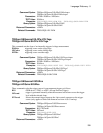
Language Dictionary - 8
133
Command Syntax
*ESE <NRf>
Parameters
0 to 255
Power-On Value
(See *PSC)
Examples
*ESE 129
Query Syntax
*ESE?
Returned Parameters
<NR1>(Register value)
Related Commands
*ESR? *PSC *STB?
CAUTION: If *PSC is programmed to 0, the *ESE command causes a write cycle to nonvolatile
memory. Nonvolatile memory has a finite maximum number of write cycles. Programs
that repeatedly cause write cycles to nonvolatile memory can eventually exceed the
maximum number of write cycles and cause the memory to fail.
*ESR?
This query reads the Standard Event Status Event register. Reading the register clears it. The bit
configuration is the same as the Standard Event Status Enable register (see *ESE).
Query Syntax
*ESR?
Parameters
None
Returned Parameters
<NR1>(Register binary value)
Related Commands
*CLS *ESE *ESE? *OPC
*IDN?
This query requests the dc source to identify itself. It returns a string composed of four fields separated
by commas.
Query Syntax
*IDN?
Returned Parameters
<AARD> Field Information
Agilent Technologies Manufacturer
xxxxxA model number followed by a letter suffix
0 zero or the unit's serial number if available
<A>.xx.xx Revision levels of firmware.
Example
AGILENT TECHNOLOGIES,66321B,0,A.00.01
*OPC
This command causes the instrument to set the OPC bit (bit 0) of the Standard Event Status register when
the dc source has completed all pending operations. (See *ESE for the bit configuration of the Standard
Event Status register.) Pending operations are complete when:
$ all commands sent before *OPC have been executed. This includes overlapped commands. Most
commands are sequential and are completed before the next command is executed. Overlapped
commands are executed in parallel with other commands. Commands that affect output voltage,
current or state, relays, and trigger actions are overlapped with subsequent commands sent to the dc
source. The *OPC command provides notification that all overlapped commands have been
completed.
$ all triggered actions are completed


















